The need for fresh water has pushed humans into exploring new and innovative techniques. For thousands of years, in regions where water is scarce, sometimes using air wells, people have harvested water from the rain, fog or even dew. In Ethiopia, we can witness an upgrade to the age-old technique. With a slick modern design, the WarkaWater will definitely improve collection of water from the surrounding environment. Standing 30 ft. tall and 13 ft. wide, the bamboo tower was envisioned by Arturo Vittori and his team, Architecture and Vision. How does it work? Well, the mesh netting installed on the structure captures moisture from the air and directs it into hygienic holding tank. Then, you can access the water via a spout. Check out the blueprints and other images involving this modern technique of collecting water!
https://youtu.be/rDXWK5GRaiQ
The WarkaWater Tower, which is easy and cheap to construct, uses no electricity and has the ability to produce up to 25 gallons of water in a day by capturing condensation and could be the answer to water scarcity in parts of the world that have little to no access to water.
A project developed by Architecture and Vision

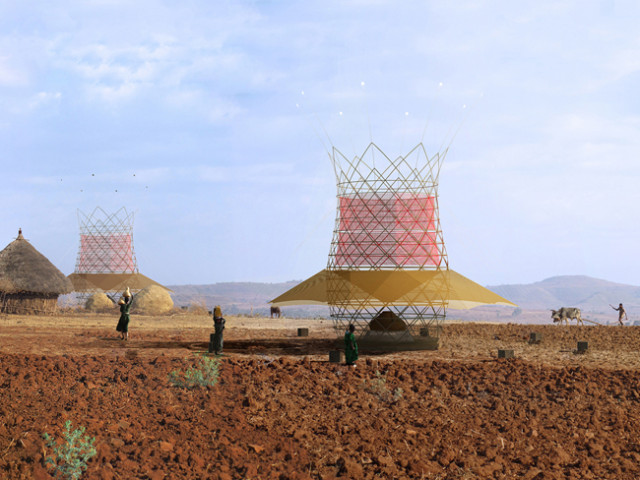
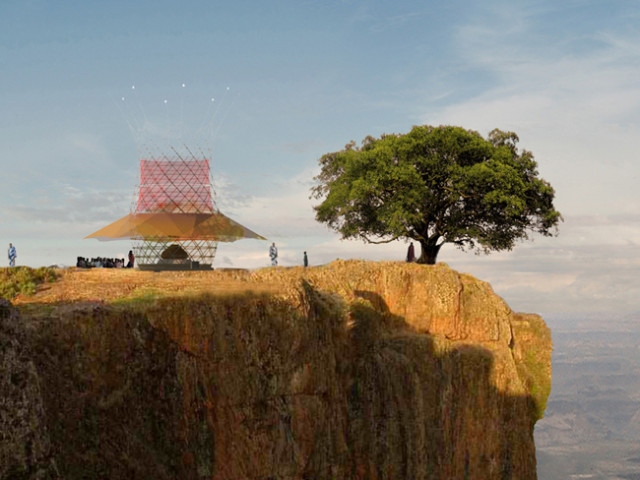
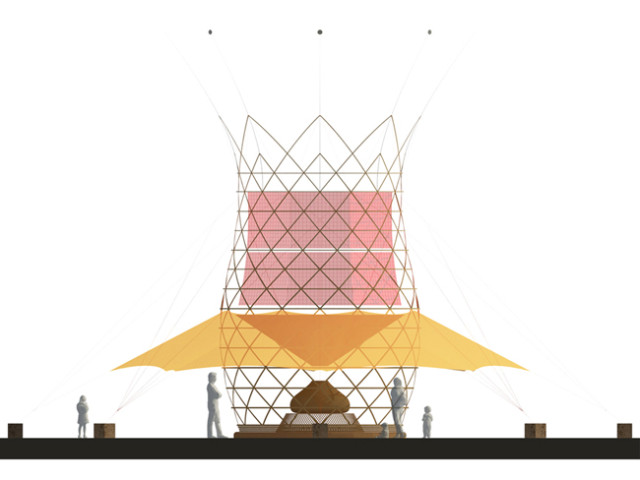
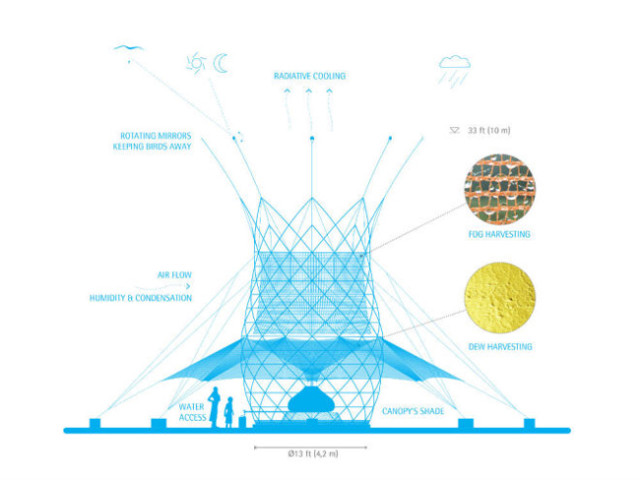
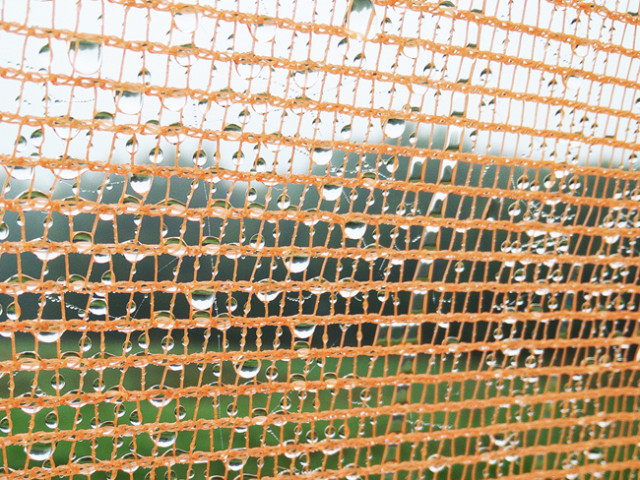
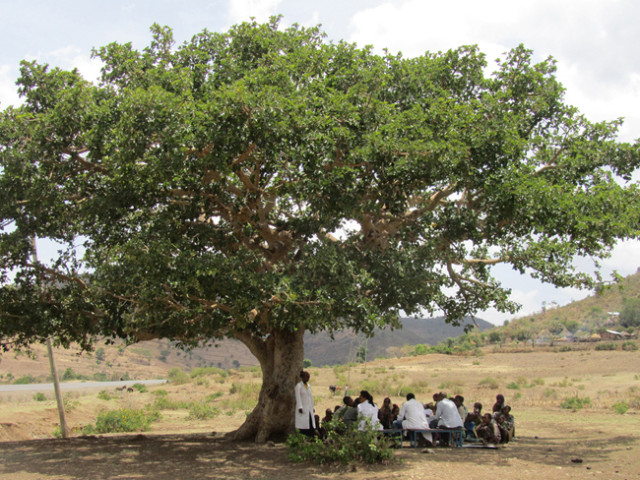
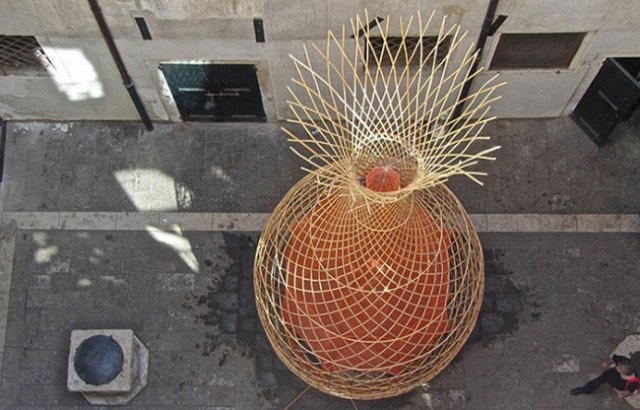

















Lissette Padilla needs to take the “talk on TV ” class. All that hand waving can be detrimental to your story.
Would of liked more details of the Actual tower (how it works etc) rather than a presenter waffling for the same of it
This link has little more details of the tower itself
Agreed. What are the tech specs, such as required minimum levels of relative humidity, temperature, …?
Search for less fancy condensation- irrigation systems in Peru and Nepal which actually work.
OSX 10.12, at least 80GB of DDR9 Ram + liquid cooling.
See Schwartx, Judith, Water In Plain Sight for details of a double roofed buliding in Western Australia that does the same thing,, creation of a temperature gradient to harvest humidity.
I love this idea! Would like info on how I can sponser one.. Maybe some organizions can get together and supply a whole village..
Contact Fr. Andrew Manning of St Mary’s Anglican Church and Chairman of Amanzimtoti conservancy as well as Guy Solomon, a bamboo farmer in Wartburg all on the east Coast of South Africa.
What is the minimum humidity and temperature range for this to work effectively?
A humidity level of not less than 86.5% plus a temperature of not less than 7 C, and not more than 15.7 C, and a precipitation level of not less than 45.62%. That should do it nicely.
Kindly get in touch regarding your product in South Africa. Thank you
Would like to learn in depth detailing of this tower. Also would like to know what should be the amount of humidity in the air to capture this water.
How about a design for a home water collection tower that is not quite so large…..we live very close to the ocean, but would like to have a fresh water collection system in case there is a failure of the electric grid here in the United States…..we are presently on a well system that serves some 140-homes….we would like to have our own private “system” for fresh water….
Skipp Metzger
Friday Harbor, Washington
Yes, agree a system to put on your own property would be great. Water rationing is no longer needed, or high water bills that basically never adjust downward. Such a great invention. Would love a kit to building in my own backyard! Also costs for a system?
Pls sent me the details on my mail id
Need more details. Installation cost. Any special atmospheric conditions etc.
This will work,but the problem is if you take water from air, climate changes will occur beyond your beliefs. This was tried in Africa a few years ago and they got drought. Can not fool around with mother nature, it usually causes other problems which are far more worse than getting water from air..
I doubt that humans, particularly on a small scale, can remove enough water from air to create a drought.
Paul, you are as wrong as can be. The towers were never tried before and drought had nothing to do with it. Africa has droughts throughout the continent almost every year. And as for the design, how silly are you that you can’t use the details in the article to build a tower? I’m sitting here with bamboo skewers making a model…the specs are found in the drawing and the materials are readily available. Wind is not a problem either as the structure offers almost no wind resistance and even collapses to change profile. The stupidity of saying that removing fluid from the atmosphere will cause drought is nonsensical. The hydrologic cycle does that exactly…why we have rain and water. Stop the dilettantist posturing and do some work…I am.
“The stupidity of saying that removing fluid from the atmosphere will cause drought is nonsensical.”
I’m not saying these extractors shouldn’t be used. They should. However, anyone who communicates so angrily and who is so convinced they understand the subtleties of ecological balance, is clearly unbalanced and dangerous to the planet, not mention the people around them.
Seriously?
Please send me the detailed design of the tower. I want to demonstrate it and replicate it in India. Is there any program that trains to construct it?
please let me know the details and the cost , if fabricated locally
Wonderful! It’s going to change the world!
Fantastic and unbelievable. Would like to know more about this project.
Want to know more
Sir want this to implement in India at latur maharashtra where water scarcity is more. Please help me if some one in India can help me in this. My mobile no is 918511671675.
Contact please
Nice work this is God giving wisdom’ free water for every BODY
Wow! Amazing! I bet this works great in a dry dessert where there is no water in the air….
Don’t you pepole think this humidity floating around is important to the planet? Is it not part of the global ecosystem? Now you want to start stealing that. I think it will cause so many problems. Over population is the problem we have as humans on this earth. The earth will fix itself.
In certain climates, trees even act as dehumidifiers by directly absorbing moisture in the air. … If cold humid air enters the forest, it is warmed, dehumidified and slow released through the leaves of the trees. As humans, we can strategically place trees and plants to moderate temperature.Dec 2, 2010
Trees – The Permaculture Research Institute
EcoSystem experts are no so much…..
I want to know more about it.
WOULD LIKE TO KNOW ABOUT THE DETAILS OF MAKING ONE , PURCHASE ONE , THE PROJECT ITSELF & CONTINUE KNOWLEDGE OF THE SCIENCE OF TIS !!!!
Ok send me detailed design so I can use it for domestic purpose, I Live in North India
My name Dr Paul Cossie, I am very interested in your product for water supply in rural villages in South Africa and Ghana . Please communicate how we could collaborate on making it a reality to save lives in Africa .
Better to use solar and wind to run well pumps.
Please send me the design as I would very much like to help with conservation of water and sustainability for our farmer’s.
great. thankfully i need more details about it, how to construct it, the required envieronment etc. thanks in advance
Is that mesh teh one like the Obamalla netting produced by hortomallas.com? Can you publish more specs on the type of netting? How closed should the meshes be without creating a hazard from wind?
My District does not have running Water or rivers & We depend mostly on rain Water or truck carted water. Truck carted Water had been recently SIGHTED by an NGO here in Fiji that water supplied to our District Community is Unhygienic.
Kindly fwd me the A – Z method of rebuilding this Water Catcher please.
Thank you.
MJR
Outstanding!
Could I get more technical details.
Install gutters on your house and a Raintank
wonderful thanks for Sharing
awesome!
i wish to build one in our barangay would you please send me details how it is done.thank you.
Where can I learn about it’s construction.
Up to 25 gallons? So anything between zero and twenty five. Not much of a guarantee.
Hi
This could be an interesting project for the desert dwellers up north. How can we acquire the construction details?
Regards
Karel
I like to know what this will cost
This is so wonderful and uplifting…..where there’s a need, there is a way! Praise God.
Where have these models currently been installed and what is the life span for it?
The dew point is the air temperature when water vapor is forced out of the air forming water droplets – which is condensation. These drops form on grass as dew or other cool surface. This happens at different temperatures depending on how wet the air is, i.e. the amount of water vapor in the air, the humidity.
A low dew point temperature means the air is drier. Phoenix Arizona air temp. can be 68 F with a -40 F dew point. Because there is almost no humidity in Arizona the temperature would have to drop to -40 F before what little water vapor existed could be forced to condense out to water drops. Meanwhile in the Midwest with its high summer humidity the dew point ranges from 60-70 F. So when the temperature drops at night to 60 the dew condenses.. The wetter (high humidity) the air, the higher the dew point.
Please let us know some of the details raised in the Comments: operational humidity and temperatures, construction details, maintenance, etc.
Thank you
dc
That’s an easy one! Depending on how much water youd want, you would use plastic tarps in a low lying 3 sided fold over a high tide intake container for sea water. As the sea water fills it during high tide, the sun goes to work heating the (black) plastic tarp and the standing sea water under it. As it rises it hits the sides and becomes heavy turning into droplets. The drops run back down the underside of the tarp and gather in the 3 corners of the tent like structure before finally falling into 3 collection containers. The containers will have fresh water because salt is too heavy to evaporate, leaving only pure water. You’re welcome.
Great information Kevin, but i’m having trouble visualising it. I’m inspired to look for more details as this would also work on heavy mineralised bore water. Thank you for the gold 🙂
If anyone has made somthing like this maybe model size it would be great if you filmed the process and could share.
In the area of the towers illustrated, there is a lot of fecal material in the soil and in the air. You can even see a cow being used to plow a field. It’s likely that, that material will be deposited on the tower by the wind. What is to keep the water on the tower hygienic, sanitary?
I know that the people in the area will be immune to such effects as they have lived with them for years. It may be that the effects are below the level to make them have to boil or otherwise sanitize the water.
I also, personally, believe that this is a brilliant idea. Simple. Elegant. Workable for many areas such as the American southwest where there are too few wells for the Tribal populations.
So, again, should you have the time to respond: What is to keep the water on the tower hygienic, sanitary?
…Tim
I disagree. For once the speaker wasn’t so boring and robotic that I was able to pay attention and listen to her as she actually seemed to care.
We need this for costal villages of the Philippines nearest the Pacific Ocean. Pls consider our marginalized area for the project and funding such drinking water systems.
Good, but far better to use trees: newscientist.com/…/mg19125631-400-catch…/ (Behind a paywall, but the first few paragraphs give you a good gist of it)
Check out The Water Rescue Foundation which used atmospheric water generators manufactured in the US and can be used world wide. These produce large quantities of water daily.
Containers around the drip line of a roof works every where except Colorado which had outlawed interference with rain water.
The Incas (or people before them from That region) did something similar along the West coast of South America to supply water to large communities. It works particularly well in high humity or fog bank areas. The ancient technology was simply to create large piles of rocks which water collection underneath. At night rocks cool the surrounding air, drop in temperature condenses the water vapor into water droplets..the water then simply needs to be gathered and piped..
nice idea; however, most people concerning themselves with climate change and the notions behind it have been misappropriating their energies. the science and the data is correct, but science looks ONLY at Degenerative Systems around the world to keep people from seeing the possibilities of what is actually possible (kinda sounding like Joel Salatin, but truth cannot be argued with, once that switch in one’s brain recognizes possibilities).
The irony of the majority of the pictures posted and along with the video, even show people plowing barren or close to inert fields in the fore-and back-ground….dear mother nature loves, loves, loves to have her soils filled with diverse microbiology (ironically, also, to which modern science hates, hates, hates because the so-called “experts” must fist deny divine creation or anything resembling a biologic sentiment and instead, everything must stem from an isolated, mechanical environment of control systems…..not to mention the flocks of people following said “science” based systems in Industrialized Food systems, Education, Governments, etc. Sequester Carbon, create keyline dams swales & strategic canals via contour lines, along with managed grazing via cells/paddocks on daily moves, bring in salad bar grasses and no matter the environment, we then have water sheds overflowing to have the aquifers filled (one thing omitted from “science” today also) so that water tables are up, overpumped wells are wet again, and springs flow like they haven’t for hundreds or in some cases, thousands of years.
We have the choice….to continue on with Degenerative Agriculture principles espoused by the millions or billions in blind monkey-see monkey do mental state; or Regenerative Agriculture thru Permaculture Principles that work 100% of the time they are actually designed with Intention. The Industry….as well as its minionship legions, shall hate, hate, hate this simple message.
I would love to have a detailed schematic with a complete list of required materials. Detailed instructions for assembly as well.
The structure is like a tent. Water raise as steam and collects on underside of the structure. Dust and animal pollutants will collect only on the top so cannot pollute the water so collected
Nice info
Where should I go for more detail?
Exactly the main problem… sounds like a design for breeding widespread Legionnaires Disease. One solution: a solar powered water ozonater would sterilize all bacteria and viruses.
Great idea … except it is still humans stealing from the earth and taking it for their own use, without leaving anything for other life on the planet to survive. We need to learn to live in sync with nature … not wage battles to see what species will survive. You see, the earth cannot support the human population explosion. The earth cannot survive the destructive forces of man.
Hi I am in South Africa and interested in this water harvesting technique, do you have any co
ntact details of the bamboo farmer you mentioned
This device would never work.
Yeah I know right? We should cut down all those tall trees to prevent them from collect dew/moister.
Ingeneous but respiring vegetation would extract more, modifying climate. A well designed and managed perennial poly culture, simulating original cover would be more productive and beneficial. Ref Australian Rural Industries Research and Development Corporation.
I don’t like the “up to” when they fail to mention the low end. Better information, please.
I am so excited for what you have created ,well done.i would like to get the design and introduce it in South Africa and other African countries .kindly email me the designs or sell it to me .
Thank you so much, God bless.
I certainly not knocking this idea, however they claim it can produce up to 25 gallons per day. This would be under optimum conditions.
Logic tells me that optimum conditions would be hot
with very high humidity with little to no wind.
I would not expect places like Ethiopia to be humid or most arid regions for that matter. I have lived in places in Australia where it is so hot and dry you can run a sopping wet sponge down the side of a car from the top to bottom in one stroke (in the shade) and the top will be dry before you are even half way down the car.
The point I am trying to make is , you can’t extract water from the air if there is no water in the air. And in harsh climates if you do manage to extract some amount, the evaporation rate would exceed the condensation rate, especially if there is a wind. In these conditions a strong wind is essentially like a giant hair dryer.
I am not an engineer or scientist but I have spent enough time in arid regions to believe this will not work anywhere near the capacity they are claiming in the areas that need water the most. The climate dictates what is possible.
It may be possible to extract water at sunrise when dew point becomes a significant factor. I am not sure how much of this is calculated into their claims.
You have no idea of global scale. A thousand of these things might extract 1 trillion of a trillions trillionth of the global atmospheres moisture. In fact that number is probably excessive, I would expect it to be much much much less than 0.000 000 000 000 000 000 000 000 001%
I would evaluate your lifestyle first before you object to people having a slightly better chance of a slightly better life. I am certain as an individual you contribute 1000x more to global problems than the average Ethiopian.
How strange, they have been on earth since time, they are called trees.
I haven’t seen anything published on this site that shows you how to make this. Could you at least show a website that you could go to so we could find out more about this. Thanks
I am interested on this… I would like to know more….
Get story, lots of.energy and informative. How can you donate to this effort for a village?